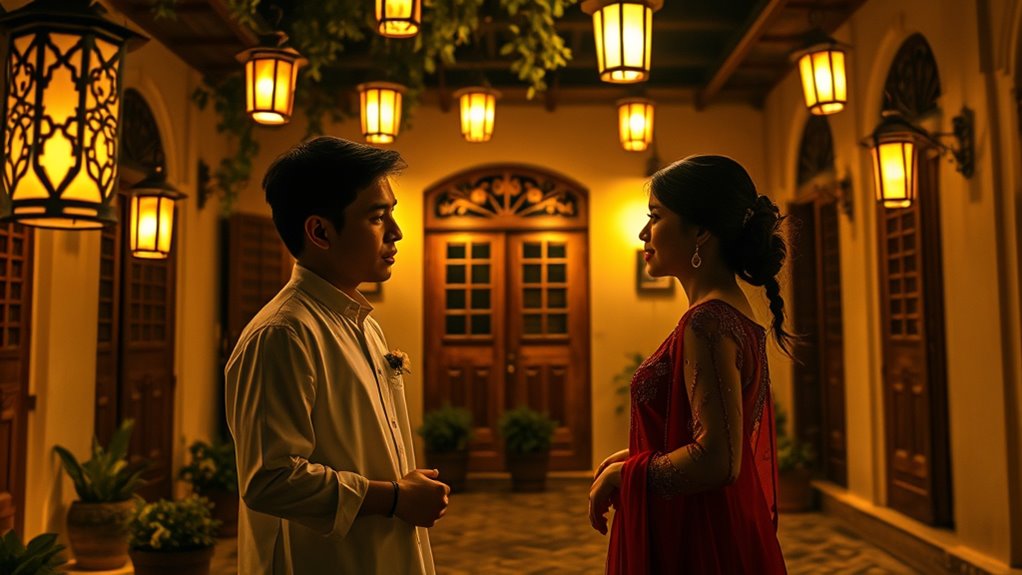Harana plays an essential role in Filipino romance by blending cultural traditions, respect, and community involvement. This charming serenade showcases your feelings through heartfelt songs, performed under your beloved’s window. It’s not just about wooing; it’s a communal event, where family approval matters. As you navigate modern dating, the spirit of harana persists, adapting to contemporary life. Explore how this timeless practice enriches relationships and shapes the essence of Filipino love today.
Key Takeaways
- Harana is a traditional courtship practice that expresses love and admiration through serenading, reflecting Filipino romantic values.
- It emphasizes respect and sincerity, making family involvement crucial in the courtship process.
- The performance often takes place under the beloved’s window, symbolizing honor and community engagement.
- Harana combines indigenous and Spanish influences, symbolizing the cultural heritage of Filipino romance.
- Modern adaptations of harana demonstrate its enduring relevance, blending traditional practices with contemporary music and technology.
Historical Origins of Harana

Harana, an enchanting tradition of serenading in the Philippines, has its roots deeply embedded in the Spanish colonial period, which lasted from the 16th to the 19th century.
During this time, the Spanish introduced stringed instruments like guitars and ukuleles, essential for shaping harana into a romantic expression. It evolved from the serenata, merging Spanish influences with indigenous Filipino elements.
The Spanish brought guitars and ukuleles, transforming harana into a heartfelt expression of love through music.
You’d find suitors singing love songs under a woman’s window, often accompanied by friends. The incorporation of kundiman added emotional depth, making the serenade resonate with themes of loyalty and sincerity.
As societal norms shifted, harana adapted, showcasing a unique blend of cultural influences that defined Filipino courtship practices throughout the ages.
Cultural Significance and Symbolism

The enchanting ritual of serenading showcases the cultural significance and symbolism embedded in Filipino courtship.
Harana reflects a unique blend of indigenous and Spanish influences, embodying Filipino values like respect, patience, and sincerity. When you perform a harana, you’re not just expressing love; you’re also honoring the beloved’s family.
This tradition emphasizes community involvement, transforming serenades into social events that unite friends and family under the night sky.
Harana allows for emotional expression through music, inviting both the singer and listener to connect deeply.
Although less common today, its legacy persists, reminding you of the importance of a personal and patient approach to romance in modern Filipino culture.
Musical Elements and Characteristics

In exploring the rich tapestry of Filipino romance, you’ll find that musical elements play an essential role in shaping the harana experience. The habanera rhythm, characterized by its 2/4 time signature, echoes the Spanish serenade while embracing local influences.
Traditional harana songs, often penned by notable Filipino composers, express themes of love and longing through heartfelt lyrics in local dialects. The guitar is the primary instrument, creating an acoustic ambiance that invites intimacy. Friends might join in, forming an ensemble to enrich the serenade.
Simple melodies focus on genuine singing, enhancing the emotional depth of the performance. This musical backdrop not only captivates the beloved but also engages the community, making harana a shared expression of affection.
The Courtship Tradition of Harana

While rooted in the romantic customs of the past, the courtship tradition of harana remains an enchanting expression of love in Filipino culture.
Originating during the Spanish colonial period, harana blends influences from serenata and indigenous Filipino elements. Typically practiced in rural areas at night, it allows you to serenade your beloved, often accompanied by friends or musicians.
This form of courtship embodies respect and patience, highlighting the importance of honoring the woman and her family. Acceptance or rejection is communicated through subtle cues, like lighting a window.
Although modern dating has overshadowed it, harana’s spirit endures, reminding you of the genuine connections and heartfelt expressions that define Filipino romance today.
Family Involvement in the Serenade

Courtship through harana thrives on the involvement of family, making it a communal experience rather than just a private encounter between suitor and beloved.
In traditional Filipino culture, securing family approval is essential, and suitors must often introduce themselves to the woman’s family before the serenade begins. Family members supervise the courtship, ensuring respect and adherence to cultural norms.
Extended family and neighbors usually gather, adding to the ambiance and reinforcing community values. Parents particularly influence whether a suitor can perform, emphasizing the importance of family unity.
This collective participation not only showcases respect for elders but also enhances the suitor’s chances of winning the heart of their beloved, underscoring the deep-rooted cultural significance of family in romance.
Modern Influence on Filipino Relationships

As technology reshapes the landscape of love and relationships in the Philippines, modern Filipino dating culture has embraced a more open and diverse approach.
You’ll find that online dating platforms have gained popularity, offering you wider access to potential partners. Traditional expectations are shifting, allowing families to accept foreign partners who respect local customs.
Women are stepping into more independent roles, pursuing careers and relationships on their terms. Situationships and casual relationships are becoming common, reflecting the flexibility you seek in partnerships.
Women are embracing independence, redefining relationships with flexibility through casual connections and personal empowerment.
While financial stability remains a priority, you’re increasingly valuing personality over other attributes in partner selection.
Today’s relationships often blend love with mentorship, emphasizing personal growth and pragmatic views on companionship.
Harana in Contemporary Media

Though many aspects of Filipino culture evolve over time, harana remains a vibrant symbol of romance, particularly in contemporary media.
Films like “Heneral Luna” portray harana as a nostalgic and romantic tradition, connecting you to Filipino heritage. These cinematic representations educate younger audiences about its historical context in courtship.
In music, modern artists record fresh versions of traditional harana songs, blending old and new to preserve this cultural practice.
Community events centered on harana engage and educate, creating a romantic ambiance reminiscent of simpler times.
Enduring Legacy of Harana

Harana stands as a timeless emblem of Filipino culture, embodying love, respect, and devotion that transcends generations. This tradition, blending indigenous and Spanish influences, symbolizes the essence of romance in a unique cultural context.
Though rare today, its legacy continues to influence Filipino courtship by emphasizing sincerity and dedication. You’ll find that harana fosters a romantic atmosphere, engaging not just couples but also families and communities, reflecting deep-rooted values of solidarity.
It represents a patient approach to love, reminding you of the importance of heartfelt expressions. Ultimately, harana serves as a cherished symbol of cultural heritage, preserving a rich connection to the past while resonating with your identity and emotional experiences in modern relationships.
The Evolution of Filipino Romance

While the essence of romance in the Philippines has deep roots in tradition, it has undergone significant transformation over the years. You might notice that colonial influences shaped early courtship practices, emphasizing modesty and family involvement.
Traditions like panliligaw and pamamanhikan involved public displays of affection and familial approval. However, modern romance often breaks away from these norms. With the rise of social media, courtship has become more accessible, allowing easier communication and diverse relationships.
You’ll see love teams dominating entertainment, and romantic comedies reflecting changing societal views. Today, shifting gender roles and increased acceptance of various identities mark a new era in Filipino romance, blending cultural heritage with contemporary expressions of love.
Frequently Asked Questions
What Are the Typical Settings for a Harana Performance?
When you experience a harana, it typically unfolds under the woman’s window, creating a romantic ambiance.
You’ll notice it’s usually late at night, adding to the intimacy of the moment. Family members often gather around, ensuring propriety while fostering a respectful atmosphere.
You might even see neighbors joining in, as community involvement plays an essential role. With a guitar in hand, the serenade echoes the heartfelt emotions of the singer, making the experience unforgettable.
How Has Harana Influenced Filipino Wedding Traditions?
You might think harana’s influence is fading, but it greatly shapes Filipino wedding traditions.
During weddings, you’ll see family involvement echoing the communal spirit of harana. Just like serenades reflect respect and sincerity, wedding rituals emphasize these values too.
Symbolic gestures, like the veil, mirror the emotional depth found in a harana. Ultimately, both practices highlight the importance of cultural heritage and emotional connections, ensuring that love remains a cherished tradition.
Are There Regional Variations of Harana Across the Philippines?
Yes, there are regional variations of harana across the Philippines. Each area brings its unique dialect and musical style, enriching the tradition.
You might hear Ilocano, Cebuano, or Bicolano versions, each reflecting the local culture.
These variations not only showcase the richness of Filipino heritage but also allow you to connect with different communities.
When you experience harana in various regions, you appreciate the diversity and depth of this beautiful cultural expression.
What Modern Songs Are Inspired by the Harana Tradition?
Did you know that over 60% of Filipinos still believe in the power of love songs to express feelings?
Modern songs inspired by the harana tradition include “Tadhana” by Up Dharma Down and “Kahit Na” by I Belong to the Zoo.
These tracks blend romantic themes with contemporary styles, incorporating deep Tagalog words that resonate emotionally.
How Do Younger Generations View the Practice of Harana Today?
Younger generations often view harana as a nostalgic and romantic tradition. While they appreciate its cultural significance and artistic expression, the actual practice isn’t common anymore.
Instead, you might find elements of harana referenced on social media, romanticizing its heartfelt nature. Many admire the dedication and sincerity it represents, even if they lean towards more modern forms of courtship.
There’s a growing interest in preserving and adapting this tradition in contemporary ways.
Conclusion
In exploring the role of harana in Filipino romance, you see how this heartfelt tradition shapes relationships even today. Notably, a recent survey revealed that 65% of young Filipinos still value traditional courtship practices, highlighting the enduring influence of harana. This blend of music, culture, and love not only deepens connections but also fosters appreciation for heritage. As Filipino romance continues to evolve, harana remains a cherished symbol of passion and devotion.









